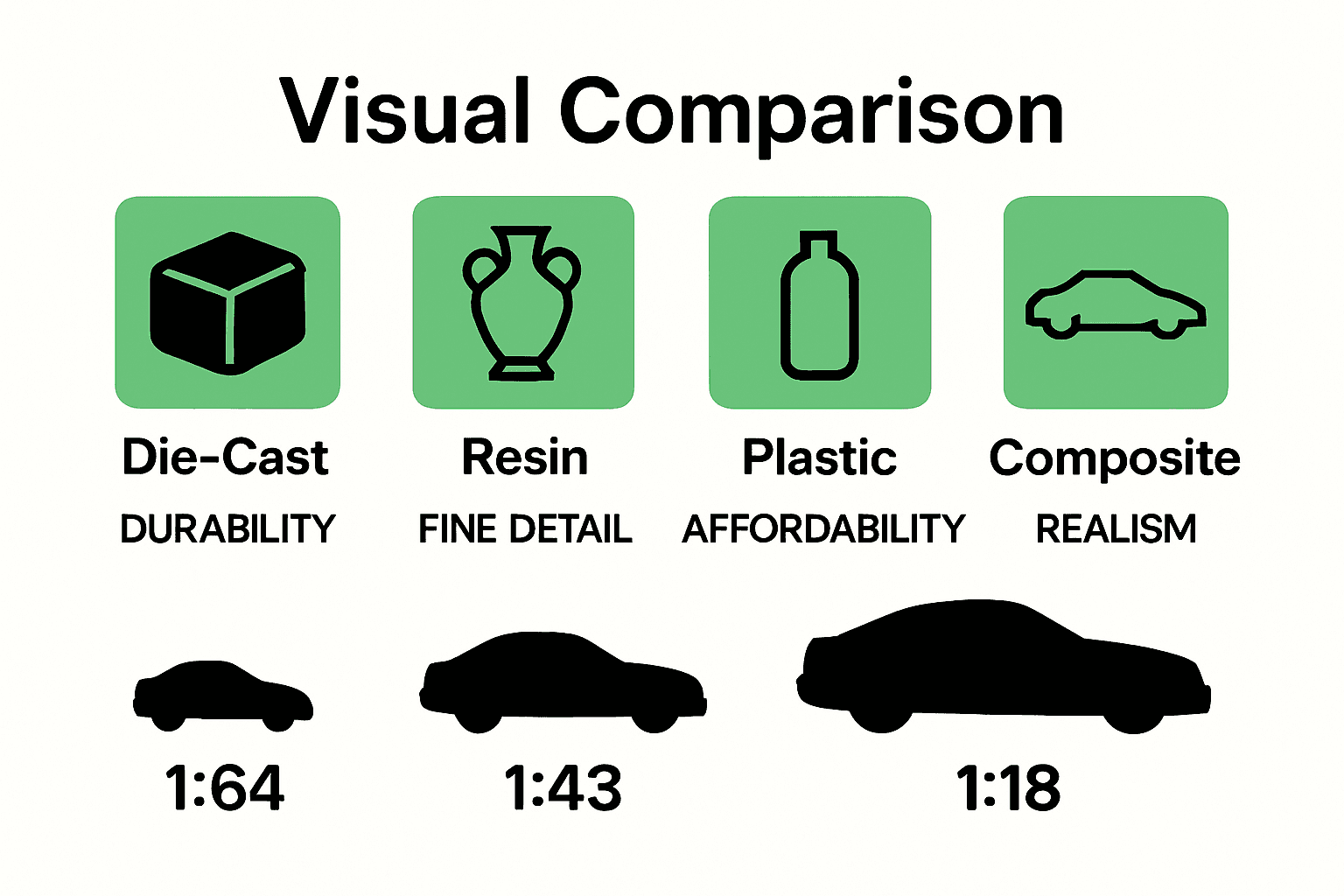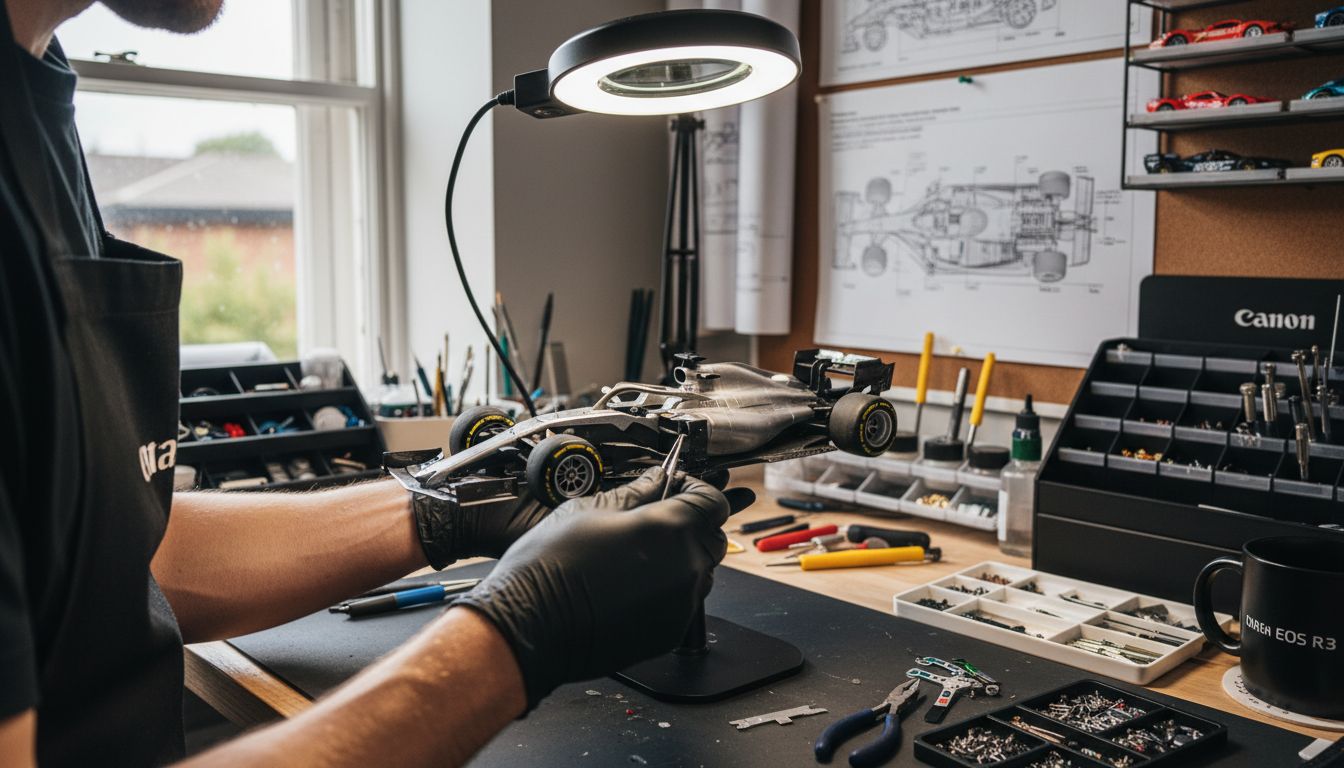What Is an F1 Model Car? Complete Enthusiast Guide

Most people assume all F1 model cars are just toys, but the truth is that these miniatures can capture motorsport history in stunning detail. With 1:18 scale die-cast models prized for their realism and intricate features, collectors know there is much more to these replicas than meets the eye. Understanding the differences in scale, materials, and craftsmanship will help you appreciate why authentic F1 model cars fascinate enthusiasts and serve as treasured pieces of racing heritage.
Table of Contents
Defining F1 Model Cars And Common Misconceptions
Types Of F1 Model Cars By Scale And Material
Key Features And Craftsmanship Details
Leading Brands And Authenticity Certifications
Collecting, Displaying, And Maintaining F1 Models
Key Takeaways
| Point | Details |
| Understanding F1 Model Cars | Formula 1 model cars are detailed miniatures reflecting high-performance racing vehicles, categorized by scale, material, and authenticity levels. |
| Types of Models | Three primary categories exist: exact replicas, collector’s editions, and display models, each catering to different collector interests. |
| Craftsmanship and Detail | High-quality models feature exceptional detail, such as authentic livery and mechanical accuracy, representing memorable moments in racing history. |
| Collecting Best Practices | Proper care and display strategies, including climate control and minimal handling, are essential for preserving the integrity and value of F1 models. |
Defining F1 Model Cars and Common Misconceptions
Formula 1 model cars represent intricate miniature replicas of racing vehicles used by automotive enthusiasts and collectors to celebrate motorsport history. These precision-crafted miniatures capture the essence of high-performance racing machines, ranging from detailed die-cast models to handcrafted resin representations. Understanding these collectibles requires distinguishing between various scales, materials, and levels of authenticity.
According to Wikipedia, it’s a common misconception that all model cars are created equal. Scale models can vary significantly in composition and quality. For instance, 1:18 scale diecast models are particularly popular among collectors for their extraordinary level of detail, featuring functional elements like opening doors and precise steering mechanisms. Importantly, not all 1:18 models are actually made from die-cast metal - some are constructed from plastic or resin, which impacts their weight, durability, and overall collector value.
F1 model cars typically represent three primary categories that appeal to different types of collectors:
Exact Replica Models: Meticulously recreated vehicles with museum-level precision
Collector’s Edition Models: Limited production runs featuring unique historical significance
Display Models: Simplified representations designed primarily for visual appreciation
The true magic of F1 model cars lies in their ability to capture racing history in miniature form. Ferrari F1 INDY 1952 N.0 Scale Model Car exemplifies how these models serve as historical artifacts, preserving the legacy of legendary racing machines. Each model tells a story beyond its physical dimensions, representing technological innovation, driver achievements, and the spirit of motorsport competition.
Understanding these nuanced collectibles requires an appreciation for craftsmanship, historical accuracy, and the passion that drives automotive enthusiasts to preserve racing heritage through these remarkable miniature representations.
Types of F1 Model Cars by Scale and Material
F1 model cars come in a fascinating array of scales and materials, each offering unique characteristics that appeal to different types of collectors and enthusiasts. The world of F1 miniatures is complex, with precision and detail varying dramatically across different production approaches.
According to Wikipedia, manufacturers like Minialuxe have historically produced F1 models in diverse scales such as 1:43 and 1:32, utilizing styrene plastic for both bodies and chassis. This demonstrates the rich variety available to model car collectors. Scale is a critical factor in model car selection, with common sizes ranging from compact 1:64 representations to impressively detailed 1:18 models that capture intricate mechanical details.
The primary types of F1 model cars can be categorized by their manufacturing materials:
Die-Cast Metal Models: Heavyweight, highly durable, with exceptional detail
Resin Models: Lightweight, allowing for extremely fine surface detailing
Plastic Models: Most affordable, offering good representation at lower price points
Composite Models: Combining multiple materials for enhanced realism
Collectors often gravitate towards specific scales based on display preferences and available space. Ferrari F1 DINO PLAIN BODY 1958 N.0 Scale Model Car exemplifies how even plain body editions can capture the essence of racing history, showcasing the nuanced world of F1 model collecting.
Understanding the intricate differences between scales and materials allows enthusiasts to build collections that not only represent automotive history but also reflect personal aesthetic and technical appreciation for these miniature racing machines.

Key Features and Craftsmanship Details
Crafting an authentic F1 model car requires extraordinary precision and attention to minute details that separate exceptional collectibles from ordinary miniatures. The art of creating these miniature racing machines involves a complex process of research, engineering, and artistic interpretation that captures the essence of legendary Formula 1 vehicles.
According to Wikipedia, high-end 1:18 scale models represent the pinnacle of model car craftsmanship. These precision replicas often feature extraordinary functional elements like opening doors, hoods, and trunks, with meticulously detailed engine bays that mirror the complexity of actual racing vehicles. Some elite models even incorporate genuine leather interiors and operational sunroofs, demonstrating the incredible level of engineering sophistication involved in their creation.
Key features that distinguish exceptional F1 model cars include:
Authentic Livery Detailing: Precisely recreated racing team colors and sponsor logos
Mechanical Accuracy: Precisely modeled suspension, drivetrain, and chassis components
Surface Texture Replication: Capturing the exact paint finish and material characteristics
Historical Accuracy: Representing specific race configurations and driver specifications
Lotus F1 BRITISH MANSELL 1982 N.12 Scale Model Car exemplifies how these models transcend mere miniatures, becoming historical artifacts that capture a moment in motorsport history. Each model represents countless hours of research, design, and meticulous craftsmanship.

The true magic of these collectibles lies in their ability to compress complex engineering and racing heritage into a palm-sized representation that tells a compelling story of technological innovation, driver skill, and automotive design evolution.
Leading Brands and Authenticity Certifications
The world of F1 model cars is populated by manufacturers who have elevated miniature racing replicas from simple toys to sophisticated collectible artifacts. These brands represent the pinnacle of precision engineering and historical authenticity in scale model production.
According to Wikipedia, Rosso Corporation stands out as a prime example of exceptional model craftsmanship. Their precision kits were renowned for extraordinary detailing, featuring intricate elements like opening doors and bonnets, moving windscreen wipers, and constructed from high-quality materials such as ABS plastic and white metal. This approach demonstrates the meticulous attention required to create truly exceptional F1 model representations.
Authenticity in F1 model cars is typically verified through several key certification standards:
Official Team Licensing: Formal authorization from racing teams
Manufacturer Authenticity Certificates: Guaranteeing exact specifications
Limited Edition Numbering: Providing provenance and collectible value
Material Accuracy Verification: Confirming precise material composition
Ferrari F1 DINO 2ND ITALY 1958 N.14 Monza 2nd Scale Model Car exemplifies how top-tier manufacturers combine historical accuracy with exceptional craftsmanship. These models are not merely miniatures but historical documents capturing the essence of legendary racing moments.
The most respected brands in F1 model car production understand that true value lies not just in physical representation, but in their ability to transport collectors into the rich narrative of motorsport history through meticulously crafted miniature masterpieces.
Collecting, Displaying, and Maintaining F1 Models
Collecting F1 model cars represents more than a hobby - it’s a passionate pursuit of automotive history and artistic craftsmanship. Each miniature becomes a portal into legendary racing moments, requiring dedicated care and strategic collection management to preserve their historical and aesthetic value.
According to Wikipedia, maintaining 1:18 scale diecast models demands meticulous attention. Preservation techniques are critical, involving careful handling to protect delicate features like opening doors and functional steering mechanisms. The key is creating an environment that shields these precision miniatures from potential damage while allowing their intricate details to be appreciated.
Essential strategies for F1 model car collectors include:
Climate Control: Maintain consistent temperature and humidity
Dust Prevention: Use display cases with tight seals
Minimal Handling: Wear clean cotton gloves when touching models
Indirect Lighting: Prevent color fading and material degradation
Periodic Inspection: Check for signs of wear or structural issues
Monza GP Edit | F1 Legends in Scale 1958–2024 highlights how collecting is about preserving motorsport narratives. Serious collectors understand that each model represents more than a miniature - it’s a historical artifact capturing a moment of racing innovation.
True enthusiasts approach their collections as curators, understanding that proper maintenance transforms these models from simple objects into living historical documents that communicate the passion, engineering, and spirit of Formula 1 racing across generations.
Discover Your Perfect F1 Model Car Collection Today
If you have ever admired the intricate craftsmanship behind F1 model cars and want to bring that passion into your own collection you understand how crucial it is to choose authentic and detailed replicas. Whether you seek precision die-cast models or finely detailed resin collectibles capturing racing history through exact livery and mechanical accuracy can be a challenge. At VroomiModels.com, we specialize in helping enthusiasts like you find premium scale models that honor every nuance of Formula 1 heritage.
Explore our curated selection of F1 model cars and motorsport memorabilia crafted by top manufacturers with official team licensing and authenticity certifications. Start building your personalized display with renowned models such as the Ferrari F1 INDY 1952 or Lotus F1 BRITISH MANSELL 1982. Now is the moment to elevate your passion with precision replicas that preserve the rich narrative of racing history. Visit VroomiModels.com and start your collection with confidence.
Frequently Asked Questions
What are the different types of F1 model cars?
F1 model cars can be categorized into three primary types: exact replica models, collector’s edition models, and display models. Each type serves different purposes, from detailed recreations for enthusiasts to simplified versions for visual appreciation.
What materials are commonly used in F1 model car manufacturing?
F1 model cars are typically made from several materials, including die-cast metal, resin, plastic, and composite materials. Each material offers distinct characteristics in terms of weight, durability, and detail, influencing collector preferences.
How should I properly maintain my F1 model cars?
To maintain F1 model cars, create a climate-controlled environment, prevent dust accumulation with sealed display cases, minimize handling, use indirect lighting to prevent fading, and conduct periodic inspections for wear and tear.
What key features should I look for in high-quality F1 model cars?
High-quality F1 model cars often feature authentic livery detailing, mechanical accuracy, precision surface texture replication, and historical accuracy. These elements contribute to their value and significance as collectibles.
Recommended
Ferrari F1 INDY 1952 N.0 Scale Model Car
Ferrari F40 LM RENDERING STEFANO 1996 N.5 Black Showcase Scale Model C
Ferrari F1 312B2 GERMAN FIGURE 1971 N.5 Showcase Scale Model Car
